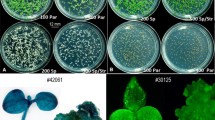Summary
One of the bottle-necks in mutation breeding of vegetatively propagated crops is the chimera formation after irradiation of multicellular apices in buds of vegetative material. This difficulty can be overcome with in vivo or in vitro adventitious bud techniques which, in combination with radiation, give almost exclusively solid, non-chimeric mutants and unmutated plants. This is usually explained on the basis of the ultimate development of the apex of adventitious shoots from single (epidermal) cells.
To investigate whether chimera formation is a matter of chance as a result of which genotypically different cells form the apex of an adventitious shoot, a stochastic model has been developed which describes the process of apex formation and by which the expected relative chimera percentages E(RCP's) are calculated. The discrepancy between these RCP's and the actual figures obtained in various crops, either propagated in vivo or in vitro, leads to the postulate that the apex of the adventitious shoot is formed from only one (epidermal) cell of the meristem or the callus. Another possibility is thatapex formation is not a random process and that the first dividing cell, forming the future meristem or callus, soon occupies the major part of this meristem, on top of which a few cells (most likely genetically identical vegetative daughter cells-mutated or unmutated) form the apex of the adventitious shootlet.
Similar content being viewed by others
References
Balkema, C. H., 1971. Chimerism and diplontic selection. Thesis (A. A. Balkema, Rotterdam, Kaapstad); pp. 173.
Broertjes C., 1969. Mutation breeding of Streptocarpus. Euphytica 18: 333–339.
Broertjes C., 1972a. Mutation breeding of Achimenes. Euphytica 21: 48–63.
Broertjes C., 1972b. Use in plant breeding of acute, chronic or fractionated doses of X-rays or fast neutrons as illustrated with leaves of Saintpaulia. Agric. Res. Rep. 776: 74 pp. Pudoc, Wageningen.
Broertjes, C., 1974. The production of polyploids using the adventitious bud technique. FAO/IAEA/Eucarpia Conf. on polyploidy and induced mutations in plant breeding, Bari, 1972: 29–35.
Broertjes, C., 1979. Mutation breeding of potato using in vitro adventitious bud techniques. In: 3nd FAO/IAEA Res. Coord. Meeting on improvement of vegetatively propagated crops and woody perennials through induced mutations. Skierniewice. Poland, May 1978 (in press).
Broertjes C. & H. Y. Alkema, 1971. Mutation breeding in flowerbulbs. First int. symp. on flowerbulbs, Noordwijk/Lisse, 1970, 11: 407–411.
Broertjes C. & J. M. Ballego, 1967. Mutation breeding in Dahlia variabilis. Euphytica 16 (2): 171–177.
Broertjes C. & A. M. vanHarten, 1978. Application of mutation breeding methods in the improvement of vegetatively propagated crops. Elsevier Scient. Publ. Co., Amsterdam; 296 pp.
Broertjes C., B. Haccius, & S. Weidlich, 1968. Adventitious bud formation on isolated leaves and its significance for mutation breeding. Euphytica 17: 321–344.
Broertjes C., S. Roest, & G. S. Bokelmann, 1976. Mutation breeding of Chrysanthemum morifolium Ram. using in vivo and in vitro adventitious bud techniques. Euphytica 25 (1): 11–19.
Dellaert, L. M. W., 1980. Comparison of selection methods for specified mutants in self-fertilizing crops: theoretical approach. In: x-ray and fast-neutron-induced mutations in Arabidopsis thaliana and the effect of dithiothreitol upon the mutant spectrum. Thesis Agric. Univ. Wageningen: pp. 168.
Doorenbos J. & J. J. Karper, 1975. X-ray induced mutations in Begonia x hiemalis. Euphytica, 24, 13–19.
Mikkelsen E. P. & K. C. Sink Jr, 1978. Histology of adventitious shoot and root formation on leaf-petiole cuttings of Begonia x hiemalis Fotsch ‘Aphrodite peach’. Scientia Hort 8: 179–192.
Naylor E. H. & B. Johnson, 1937. A histological study of vegetative reproduction in Saintpaulia ionantha. Am. J. Bot. 24: 673–678.
Roest S. & G. S. Bokelmann, 1975. Vegetative propagation of Chrysanthemum morifolium Ram. in vitro. Scientia Hort. 3: 317–330.
Roest S. & G. S. Bokelmann, 1976. Vegetative propagation of Solanum tuberosum L. in vitro. Potato Res. 19: 173–178.
Roest, S. & G. S. Bokelmann, 1980. In vitro adventitious bud techniques for vegetative propagation and mutation breeding of potato (Solamum tuberosum L.). I. Vegetative propagation in vitro through adventitious shoot formation. Potato Research 23 (in press).
Shevchenko V. V., I. I. Grinikh, & V. A. Avetisov, 1977. Application of somatic tissue culture in the investigation of development of inflorescences and leaves from initial cells of Arabidopsis thaliana. Genet. Abstr. 9 (11): 168.
Sparrow A. H., Rh. C. Sparrow & L. A. Schairer, 1960. The use of X-rays to induce somatic mutations in Saintpaulia. African Violet Magazine 13 (4): 32–37.
van Harten, A. M., H. Bouter & C. Broertjes, 1980. In vitro adventitious bud techniques for vegetative propagation and mutation breeding of potato (Solanum tuberosum L.). II. The significance for mutation breeding. Potato Research (in preparation).
Author information
Authors and Affiliations
Rights and permissions
About this article
Cite this article
Broertjes, C., Keen, A. Adventitious shoots: Do they develop from one cell?. Euphytica 29, 73–87 (1980). https://doi.org/10.1007/BF00037251
Received:
Issue Date:
DOI: https://doi.org/10.1007/BF00037251




